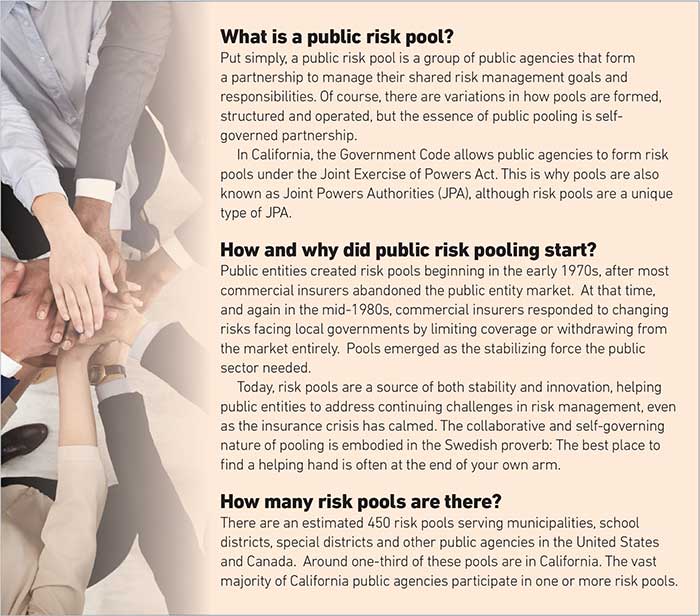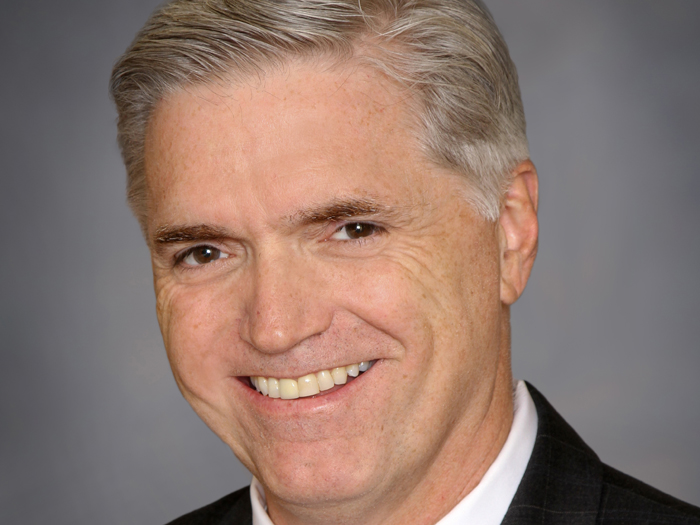What Public Sector Risk Pools Can Teach Private Sector Risk Managers

Public entity risk sharing pools were first developed as a means to address unique exposures for which limited insurance products were available.
These pools have existed for decades, and as exposures expand and evolve, they have become highly efficient risk management entities.
At a time when hardening commercial markets are enticing industries and business groups to explore new options, best practices and lessons learned in the public sector could help others improve their risk management and risk transfer strategies.
Collaboration and Risk Sharing
Public risk pools came about in the 1970s and 1980s as commercial insurers left the public market for liability and workers’ compensation. Since then, they have grown to address risk in many public areas.
Eighty percent of the 90,000 public entities in the United States now participate in one or more risk pools, according to the Association of Governmental Risk Pools.
Risk pools come in a variety of forms and operating models, said Raul Plasensia, ASLI, ARM-P, executive vice president at Risk Placement Services. Depending on the state or region, these pools will collectively self-retain primary layers of risk then buy insurance or reinsurance to cover excess risk issues.
While some pools primarily serve an administrative roll and operate a separate insurance program for each member, others actively share risk like a mutual insurance company. Models are often determined by the level of risk and financial wherewithal of the members.
“The best pools will have a good balance of a certain amount of sharing, but at the same time believing the primary responsibility lies within the pool members,” Plasensia said.
Mature pools that have been in operation for years, typically have more money and the ability to self-retain more risk.
Most will also have a sophisticated risk management team and operate like a “mini insurance company,” Plasensia said.
This includes a best practice approach to control who is in the pool, how it operates, pricing, sharing, loss prevention and claims management practices.
Best Practices and Innovation
While public risk pools can operate differently, many share some common best practices.
The Ohio Transit Risk Pool has more than two dozen members, all of which are purely public transit companies. Being able to focus tightly on their own niche needs enables better risk management and the ability to deliver more value, said Barbara Rhoades, CEO of the Ohio Risk Transit Pool.

Barbara Rhoades, CEO, Ohio Risk Transit Pool
OTRP is operated by members of the pool and has one full-time risk manager. Like many successful pools, it has strong buy-in where members are working collectively towards a common goal. As opposed to a commercial policy, where insureds simply shift risk, pools have members that actively try to manage risk and loss.
“One of the things public entities do very well is really laser focus on their specific risk as opposed to commercial insurance where you’re writing all kinds of lines and seeing all kinds of insured,” Rhoades said.
Collective unity offers pools bargaining power and enables them to offer enhanced resources to members, said Rhoades, who is also a board member of the Association Government Risk and Insurance Pools.
Like many mature risk pools, the OTRP has developed sophisticated high-level risk management information systems to track member data, the protocols, the controls they have on their members and member buy-in.
OTRP also often collaborates with other pools in the same space to share best practices and develop new tools. For example, collaboration with the Washington State Transit Insurance Pool led to the creation of a comprehensive driver training program.
“By bringing in the people who were doing the operations every day, we were really able to develop a product that really benefited [the insureds],” Rhoades said.
The Ohio Transit Risk Pool also conducts an annual deep dive to identify trends and possible gaps, Rhoades said. One thing the pool developed from the annual analysis was a specialized training program called “Smoking Your Vehicle.”
The drill simulated a fire with a water vapor machine that creates harmless thick, white smoke so the driver can learn how to feel their way out of the vehicle in an emergency. The ability to give drivers hands-on experience in such events can save lives and reduce risk, Rhoades said.
When it comes to underwriting, the ability to quickly issue questionnaires and receive responses often enables the pool to measure and manage risk more efficiently and effectively than traditional commercial insurers.
While the traditional market may have long delays in questionnaires, data changes and getting systems updated, it can happen quite quickly in a collaborative pool with strong buy-in, Rhoades said. For example, high-profile incidents, changing regulations, or new safety procedures, can all be reflected in risk analysis and pricing.
“Risk pools are a lot more nimble when it comes to making those kinds of changes and getting that information back from the members, because our members are sitting at the table with us, deeply engaged,” Rhoades said.
With strong buy-in and a common goal among members, public pools can also quickly get out ahead of trends to offer niche services.

Upon discovering that many of its members were lending buses to educational institutions, the OTRP was able to quickly institute a “borrow-a-bus” legal agreement to ensure appropriate risks were being addressed.
“We can react in real time because of a very specified need that they have. I’m not sure any commercial carrier is ever going to be that connected,” Rhoades said.
A Model for Other Sectors
Risk pooling has been employed more in recent years across several industries and within captives. Common risks include catastrophe, high-risk health, employee benefits, political risk and cyber risk.
Any risk for which insurance is experiencing significant hardening could come together to make a purchase where the administration of risk insurance could be more viable, said Jose Peralta, ARM-P, director of the public sector at Aon.
“I think that principally is a form that can be adopted in really any place that’s seeing severe risk, which is something we’re seeing quite a bit now across different lines of coverage,” Peralta said.
More than four in ten risk managers have used or expect to use alternate risk transfer solutions in the coming years, according to Marsh’s Excellence in Risk Management XVI report. One-third of companies said they are actively looking for more information on risk transfer through things like captives and risk retention groups.
While public risk pools span sectors and use several models, individual pools are often bound by a strong tie, usually operation within the same government, entity,or area of business.
One of the largest risk retention groups is United Educators, a pool that was founded in 1987 and offers liability insurance and risk management services to more than 1,600 members representing schools and colleges.
UE considers itself a partner to its members and provides what it calls a “stable alternative to the cyclical fluctuations in the commercial insurance market” with stable premiums and evolving liability coverage.
UE has an average of 2.9 policy counts per member and a 98 % 10-year average premium retention rate. Nearly 70% of its members use its risk management services, which include events, online sources, publications, professional advice and risk management premium credit.
Like many successful pools, UE fosters ongoing expansion and value while emphasizing premium stability.
In 2019, the group enhanced liability coverage with defense coverage for Individualized Education Programs and a lower self-insured retention to $250,000.
The move was part of an ongoing shift to address large losses, said Joe Carter, UE vice president of business development, in a press release.
“We’re ready to welcome districts of all sizes into UE’s prevention and protection partnership,” he said.
In a hardening insurance market, pools will become more attractive and a growing trend in the future, Rhoades said.
“The beauty is that you can assume more risk and buy less insurance at those support limits until the market softens again, she said. &










